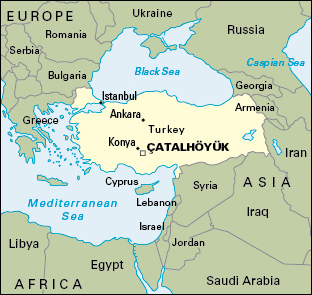Çatalhöyük << chah tal HOY yook >>, also spelled Çatal Höyük, an ancient town in the Middle East, was one of the earliest large human settlements. People lived there between about 7200 and 5500 B.C., during the Neolithic Period (New Stone Age). During this period, the first farming communities arose in the ancient Middle East. The town was built about 37 miles (60 kilometers) southeast of Konya in southern Turkey. The ancient name of the town is unknown. The modern name is Turkish for fork mound, because a river divides the site into two mounds, east and west. Archaeologists first excavated the site from 1961 to 1965. Since 1993, an international team of archaeologists has continued excavations. Çatalhöyük is important to archaeologists studying the origins of urbanism (living in cities).

Archaeologists estimate that ancient Çatalhöyük had a population between 5,000 and 10,000. The people of the town grew grain and herded sheep and goats. They also hunted wild cattle, deer, and other animals and gathered edible plants in the surrounding area.
The people of Çatalhöyük built their houses from bricks of dried mud, with wooden frames and flat roofs. In some areas, houses crowded together with no streets or alleys. People would have moved through such areas on the roofs, entering homes through rooftop openings. In other areas, there was more space between buildings. People could enter houses there through doorways. Most houses consisted of a single, rectangular room. Short walls divided the large room, along with clay platforms for sitting, sleeping, and eating. A kitchen area occupied one section of the house.
Çatalhöyük is famous for the spectacular art preserved inside the houses. The simplest homes were decorated with a single color of paint. But other homes had more elaborate paintings, including complicated geometric designs, such as zigzag or net patterns. Some houses had decorative scenes, such as birds and plants, the hunting of deer or wild cattle, and landscapes with a village and mountains in the background. People also made sculptures that stuck out from their walls. Animals, such as leopards and antelope, were common subjects. Archaeologists have also found stylized heads of bulls and goats made by placing clay over an animal skull or a frame. Çatalhöyük sculptors made figurines of women, men, and animals with clay and stone.
The people of Çatalhöyük buried their dead beneath the floors of their houses. Archaeologists have found many bodies buried together inside homes, usually under a single clay platform. As new bodies were added, people often displaced and mixed the bones of previous burials, and sometimes removed them. People sometimes buried a few items with the dead. Such items include clay figurines, stone knives, and stone mirrors.
Çatalhöyük declined toward the end of the 5000’s B.C. for unknown reasons. Archaeologists have noticed that changes occurred at the site toward the later Neolithic. The people built smaller and fewer houses, with more space between them. Many of the dwellings were not fully decorated. Eventually, only the west mound was occupied. The people of Çatalhöyük then largely abandoned the site. Also found at the site are a few homes and burials from the later Roman and Byzantine periods.
In 2012, the United Nations Educational, Scientific and Cultural Organization (UNESCO) declared Çatalhöyük a World Heritage Site. UNESCO considers such sites to be areas of unique natural or cultural importance.
